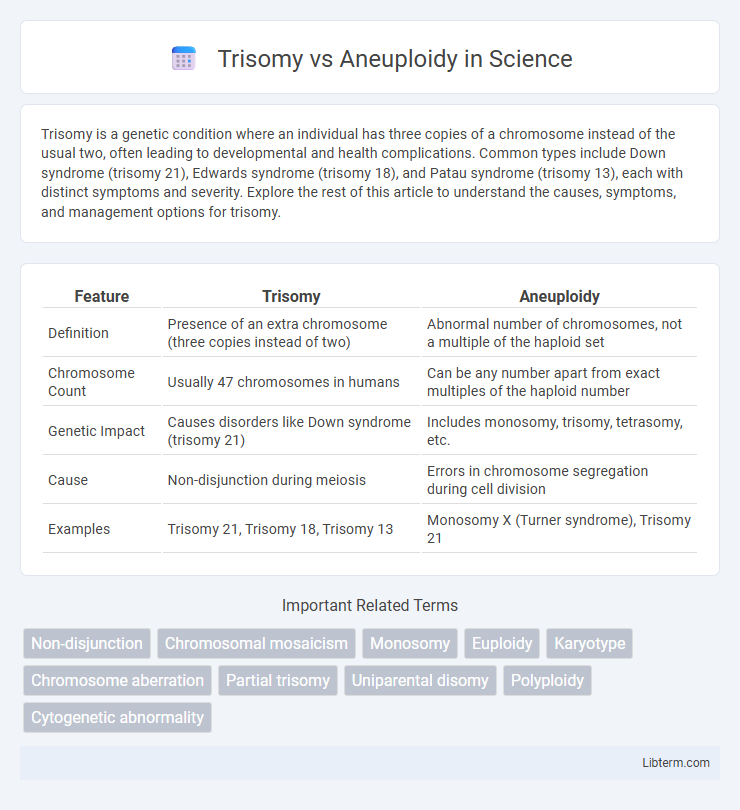Trisomy is a genetic condition where an individual has three copies of a chromosome instead of the usual two, often leading to developmental and health complications. Common types include Down syndrome (trisomy 21), Edwards syndrome (trisomy 18), and Patau syndrome (trisomy 13), each with distinct symptoms and severity. Explore the rest of this article to understand the causes, symptoms, and management options for trisomy.
Table of Comparison
| Feature | Trisomy | Aneuploidy |
|---|---|---|
| Definition | Presence of an extra chromosome (three copies instead of two) | Abnormal number of chromosomes, not a multiple of the haploid set |
| Chromosome Count | Usually 47 chromosomes in humans | Can be any number apart from exact multiples of the haploid number |
| Genetic Impact | Causes disorders like Down syndrome (trisomy 21) | Includes monosomy, trisomy, tetrasomy, etc. |
| Cause | Non-disjunction during meiosis | Errors in chromosome segregation during cell division |
| Examples | Trisomy 21, Trisomy 18, Trisomy 13 | Monosomy X (Turner syndrome), Trisomy 21 |
Understanding Chromosomal Abnormalities
Trisomy is a specific type of aneuploidy characterized by the presence of an extra chromosome, resulting in three copies instead of the normal two, as seen in conditions like Down syndrome (Trisomy 21). Aneuploidy broadly refers to any deviation from the normal chromosome number, including both extra or missing chromosomes, impacting cellular function and development. Understanding chromosomal abnormalities involves analyzing these variations in chromosome number, which can lead to genetic disorders, developmental delays, and various medical complications.
What is Aneuploidy?
Aneuploidy refers to the presence of an abnormal number of chromosomes in a cell, deviating from the typical diploid number. This genetic anomaly involves either the loss or gain of one or more chromosomes, resulting in conditions such as monosomy or trisomy. Trisomy is a specific type of aneuploidy where an individual has three copies of a particular chromosome instead of the usual two.
Defining Trisomy
Trisomy is a specific type of aneuploidy characterized by the presence of an extra chromosome, resulting in three copies instead of the normal two. This chromosomal abnormality leads to genetic disorders such as Down syndrome, which is caused by trisomy 21. Aneuploidy broadly refers to any deviation from the normal number of chromosomes, including both trisomies and monosomies.
Key Differences Between Trisomy and Aneuploidy
Trisomy is a specific type of aneuploidy characterized by the presence of an extra chromosome, resulting in three copies instead of the typical two, commonly observed in conditions like Down syndrome (Trisomy 21). Aneuploidy broadly refers to any deviation from the normal chromosome number, including both the gain or loss of one or more chromosomes, such as monosomy or trisomy. The key difference lies in trisomy's precise chromosomal increase, while aneuploidy encompasses all chromosomal numerical abnormalities affecting any chromosome pair.
Types of Aneuploidy Explained
Types of aneuploidy include trisomy, monosomy, and nullisomy, each characterized by variations in chromosome number. Trisomy occurs when there is an extra chromosome, such as in Trisomy 21 (Down syndrome), while monosomy involves a missing chromosome, as seen in Turner syndrome (monosomy X). Nullisomy, a rare and usually lethal condition, refers to the loss of both homologous chromosomes from a pair, drastically impacting cellular function and development.
Common Trisomy Disorders
Trisomy is a specific type of aneuploidy characterized by the presence of an extra chromosome, resulting in three copies instead of the usual two. Common trisomy disorders include Trisomy 21 (Down syndrome), Trisomy 18 (Edwards syndrome), and Trisomy 13 (Patau syndrome), each associated with distinct developmental and physical abnormalities. Aneuploidy encompasses any deviation from the normal chromosome number, including monosomy and other trisomies, affecting genetic balance and cellular function.
Causes and Risk Factors
Trisomy is a specific type of aneuploidy characterized by the presence of an extra chromosome, resulting in three copies instead of the usual pair, commonly caused by nondisjunction during meiosis. Aneuploidy, a broader category of chromosomal abnormalities, arises from errors in chromosome segregation leading to missing or extra chromosomes, often influenced by maternal age, environmental factors, and genetic predispositions. Advanced maternal age remains the most significant risk factor for both trisomy and other forms of aneuploidy, as it increases the likelihood of meiotic errors during oocyte development.
Diagnostic Methods for Chromosome Abnormalities
Chromosome abnormalities such as trisomy and aneuploidy are primarily diagnosed through techniques like karyotyping, fluorescent in situ hybridization (FISH), and chromosomal microarray analysis (CMA). Karyotyping enables visualization of entire chromosome sets to detect trisomies, where an extra copy of a chromosome is present, while FISH targets specific chromosome regions for rapid aneuploidy detection. CMA offers high-resolution analysis to identify submicroscopic chromosomal imbalances, enhancing the detection of both trisomic and other aneuploid conditions.
Clinical Implications and Outcomes
Trisomy, a specific type of aneuploidy characterized by an extra chromosome copy, frequently results in distinct clinical syndromes like Down syndrome (Trisomy 21), with developmental delays and congenital abnormalities. Aneuploidy, encompassing any abnormal chromosome number, often causes miscarriage, infertility, or severe phenotypic abnormalities depending on the affected chromosome. Clinical outcomes vary widely; trisomies commonly lead to recognizable syndromes with established prognoses, whereas non-trisomic aneuploidies may present with less predictable or more lethal conditions.
Management and Counseling for Affected Individuals
Management of trisomy, a specific form of aneuploidy characterized by an extra chromosome, involves multidisciplinary care including genetic counseling, developmental support, and medical monitoring tailored to the particular syndrome such as Down syndrome (Trisomy 21) or Edwards syndrome (Trisomy 18). Counseling for affected individuals emphasizes personalized risk assessment, family planning options, and psychosocial support to address cognitive and physical challenges associated with chromosomal abnormalities. Early intervention programs and continuous evaluation by healthcare professionals optimize quality of life and developmental outcomes for those affected by aneuploid conditions.
Trisomy Infographic

 libterm.com
libterm.com